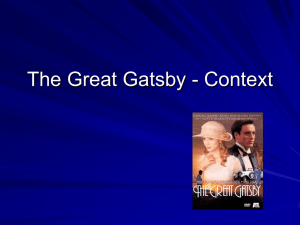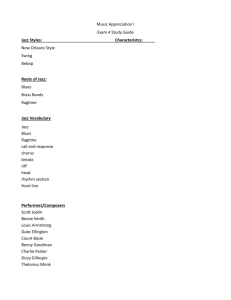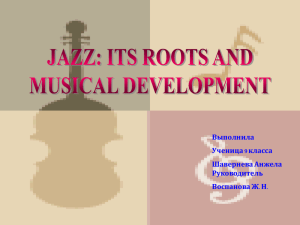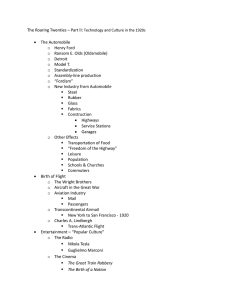Jazz - TeacherWeb
advertisement
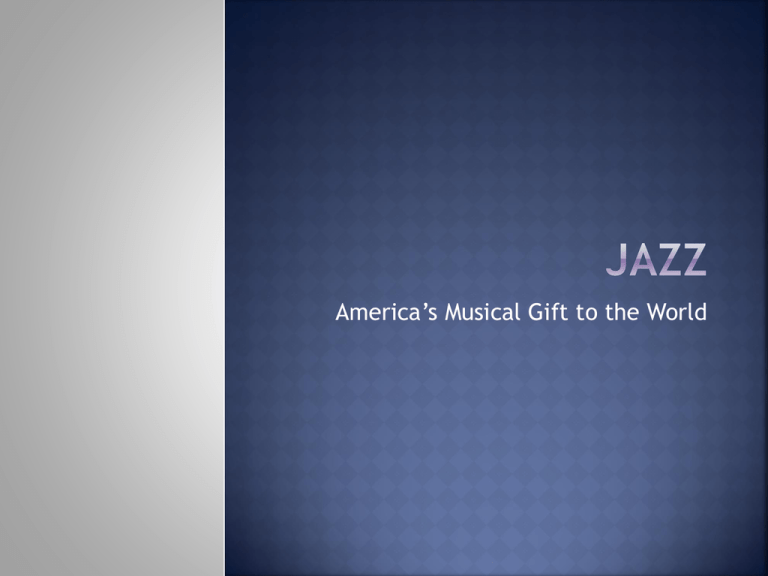
America’s Musical Gift to the World Name three cities that Jazz music was popular in, during the early 1900s. Give the years in which jazz was popular in these cities. The roots of jazz in and around New Orleans extend back into the nineteenth century Jazz was influenced by gospel and blues, but the most direct ancestor seems to have been brass and minstrel bands of New Orleans These bands used the classical instruments of the daytrumpets, trombones, clarinets, saxophones, and drums Ferdinand “Jelly Roll” Morton (18851941), was one of the key figures in the early jazz movement in New Orleans. He was a pianist and band leader who helped bring together many varied African American musical elements that were the building blocks of early jazz. Jelly Roll Morton claimed to begin using the term “jazz” in 1902 to distinguish the new style from ragtime. He and his group, “Jelly Roll Morton and His Red Hot Peppers,” introduced a new swinging drive in their recording of “Black Bottom Stomp” (1926). Listen to it! During WWI (U.S. entered in 1917) musicians went North from New Orleans up the Mississippi looking for work in St. Louis and Chicago. Chicago became the next hot spot for jazz During the Roaring Twenties, teenagers shocked their parents by dancing to the Charleston and the Black Bottom. Also during this time, the 19th amendment passed (giving women the right to vote) (1920) The Charleston was the dance that captured the spirit of the 1920s. It was danced with wild abandon by a new generation of independent young Americans, to the new hot jazz that was flooding the country. The dance began in Charleston, South Carolina, the city from which it takes its name. In 1923, The Charleston was featured in the Broadway show Runnin Wild, one of the biggest hits of the decade. The song from the show James P. Johnsons tune The Charleston - spread the fad across the nation and onwards to the rest of the world. The Charleston is both a solo and partnered dance, both wildly exuberant and exciting to watch. As the hot jazz of the 1920s gave way to the swingin jazz of the 1930s and 40s, the partnered version of Charleston evolved into Lindy Hop. The Black Bottom Dance Dance The Charleston Developed in New Orleans, which was the major center of Jazz during the 1st two decades of the 20th century Collective improvisation of each instrument was the main feature of New Orleans Jazz. 1. A. B. C. 1. A. B. C. D. E. F. Most popular style during this time usually played by 5-8 performers Front Line: Melodic instruments Cornet or trumpet Clarinet Trombone Rhythm section Drums Piano Banjo Guitar Tuba Plucked bass Ex. Mentor and teacher of Louis Armstrong Louis Armstrong, one of the jazz giants, was a trumpet player from New Orleans, from where he went on to reach international stardom Armstrong’s playing was unique and masterful and he took the trumpet to new heights of musical expression. The way he played, influenced the way every other musician in the band played. Single handedly, Armstrong established the standard for solo jazz artistry. He was said to be phenomenal on both the trumpet, and with his scat singing. Scat singing- a form of vocal improvisation (spontaneous singing) Life of Louis Armstrong Towards the end of the Roaring twenties, a new kind of jazz began to emerge- swing. Swing- the special rhythmic character that jazz musicians add to the music Swing became not only a label for a style, but for an era as well (1935-1945) Duke Ellington- one of the most important composers, arranger, and conductor of the swing era Played by mostly big bands (15 players in 3 sections) Saxophone- key solo instrument during this era Both other styles of Jazz Big Band- 1930s to the end of the 1940s Played a lot of swing style music Saxophone was instrument of choice Bebop- 1940s after WWII Some younger jazz musicians wanted the freedom to create outside the confines of swing Bebop was invented in Harlem jam sessions that took jazz back to smaller combo Complex and sophisticated type of improvised jazz Known as “modern jazz” More listening instead of dancing Late 1940’s and early 50’s Related to bop but far calmer and more relaxed Miles Davis- leading musician in cool jazz and in jazz rock (fusion) Ex. 1960’s Not based on regular forms and established chord patterns John Coletrane- influential as an improviser, saxophonist, and composer Ex. 1960’s Mixing jazz musician’s improv with rock musical forms, rhythms, and tone colors Ex. Chicago and Blood, Sweat, and Tears 1890’s-1915 Style of composed piano style, generally in duple meter (2 beats in the same bar), and performed at a moderate march tempo Scott Joplin “king of ragtime”- most famous piece was the Maple Leaf Rag Form of vocal and instrumental music and to style of performance W.C. Handy- Memphis Blues and St. Louis Blues Bessie Smith- “Empress of the Blues”- most famous blues singer in the 1920’s 12 bar blues- chord progression usually usedinvolves 3 basic chords: tonic, subdominant, and dominant • Own your own sheet of paper, you will write your own blues song • Read the handout first, then begin writing • Begin your song with • “Well I woke up this morning…” • Carefully read the key words/ phrases for help • Use your “blues name” to write who the song is written by • Your song needs 1) A title 2) 3 repeating stanzas (paragraphs) 3) Written by your “blues name” • BE CREATIVE, HAVE FUN!!! Listen to Lucille
